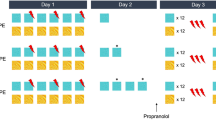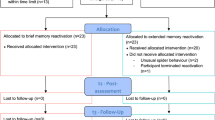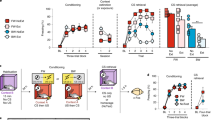Abstract
Recent research on changing fears has examined targeting reconsolidation. During reconsolidation, stored information is rendered labile after being retrieved. Pharmacological manipulations at this stage result in an inability to retrieve the memories at later times, suggesting that they are erased or persistently inhibited. Unfortunately, the use of these pharmacological manipulations in humans can be problematic. Here we introduce a non-invasive technique to target the reconsolidation of fear memories in humans. We provide evidence that old fear memories can be updated with non-fearful information provided during the reconsolidation window. As a consequence, fear responses are no longer expressed, an effect that lasted at least a year and was selective only to reactivated memories without affecting others. These findings demonstrate the adaptive role of reconsolidation as a window of opportunity to rewrite emotional memories, and suggest a non-invasive technique that can be used safely in humans to prevent the return of fear.
This is a preview of subscription content, access via your institution
Access options
Subscribe to this journal
Receive 51 print issues and online access
$199.00 per year
only $3.90 per issue
Buy this article
- Purchase on Springer Link
- Instant access to full article PDF
Prices may be subject to local taxes which are calculated during checkout



Similar content being viewed by others
References
Miracle, A. D., Brace, M. F., Huyck, K. D., Singler, S. A. & Wellman, C. L. Chronic stress impairs recall of extinction of conditioned fear. Neurobiol. Learn. Mem. 85, 213–218 (2006)
Misanin, J. R., Miller, R. R. & Lewis, D. J. Retrograde amnesia produced by electro-convulsive shock after reactivation of a consolidated memory trace. Science 160, 554–555 (1968)
Alberini, C. M. Mechanisms of memory stabilization: are consolidation and reconsolidation similar or distinct processes? Trends Neurosci. 28, 51–56 (2005)
Nader, K., Schafe, G. E. & LeDoux, J. E. Fear memories require protein synthesis in the amygdala for reconsolidation after retrieval. Nature 406, 722–726 (2000)
Dudai, Y. Reconsolidation: the advantage of being refocused. Curr. Opin. Neurobiol. 16, 174–178 (2006)
Sara, S. J. & Hars, B. In memory of consolidation. Learn. Mem. 13, 515–521 (2006)
Hupbach, A., Gomez, L., Hardt, O. & Nadel, R. Reconsolidation of episodic memories: a subtle reminder triggers integration of new information. Learn. Mem. 14, 47–53 (2007)
Monfils, M.-H., Cowansage, K. K., Klann, E. & LeDoux, J. E. Extinction-reconsolidation boundaries: key to persistent attenuation of fear memories. Science 324, 951–955 (2009)
Squire, L. R. & Davis, H. P. The pharmacology of memory: a neurobiological perspective. Annu. Rev. Pharmacol. Toxicol. 21, 323–356 (1981)
McGaugh, J. L. Memory—a century of consolidation. Science 287, 248–251 (2000)
Duvarci, S. & Nader, K. Characterization of fear memory reconsolidation. J. Neurosci. 24, 9269–9275 (2004)
Alberini, C. M., Milekic, M. H. & Tronel, S. Memory: mechanisms of memory stabilization and de-stabilization. Cell. Mol. Life Sci. 63, 999–1008 (2006)
Lee, J. L., Milton, A. L. & Everitt, B. J. Reconsolidation and extinction of conditioned fear: inhibition and potentiation. J. Neurosci. 26, 10051–10056 (2006)
Doyère, V., Debiec, J., Monfils, M. H., Schafe, G. E. & LeDoux, J. E. Synapse-specific reconsolidation of distinct fear memories in the lateral amygdala. Nature Neurosci. 10, 414–416 (2007)
Myers, K. M., Ressler, K. J. & Davis, M. Different mechanisms of fear extinction dependent on length of time since fear acquisition. Learn. Mem. 13, 216–223 (2006)
Alvarez, R. P., Johnson, L. & Grillon, C. Contextual-specificity of short-delay extinction in humans: renewal of fear-potentiated startle in a virtual environment. Learn. Mem. 14, 247–253 (2007)
Schiller, D. et al. Evidence for recovery of fear following immediate extinction in rats and humans. Learn. Mem. 15, 394–402 (2008)
Walker, M. P., Brakefield, T., Hobson, J. A. & Stickgold, R. Dissociable stages of human memory consolidation and reconsolidation. Nature 425, 616–620 (2003)
Forcato, C. et al. Reconsolidation of declarative memory in humans. Learn. Mem. 14, 295–303 (2007)
Squire, L. H. & Knowlton, B. J. in The New Cognitive Neurosciences (ed. Gazzaniga, M. S.) 765–780 (MIT Press, 2000)
Phelps, E. A., Delgado, M. R., Nearing, K. I. & LeDoux, J. E. Extinction learning in humans: role of the amygdala and vmPFC. Neuron 43, 897–905 (2004)
Kalisch, R. et al. Context-dependent human extinction memory is mediated by a ventromedial prefrontal and hippocampal network. J. Neurosci. 26, 9503–9511 (2006)
Milad, M. R. et al. Recall of fear extinction in humans activates the ventromedial prefrontal cortex and hippocampus in concert. Biol. Psychiatry 62, 446–454 (2007)
LeDoux, J. E. Emotion circuits in the brain. Annu. Rev. Neurosci. 23, 155–184 (2000)
Bouton, M. E. Context, ambiguity, and unlearning: sources of relapse after behavioral extinction. Biol. Psychiatry 52, 976–986 (2002)
Quirk, G. J. & Mueller, D. Neural mechanisms of extinction learning and retrieval. Neuropsychopharmacology 33, 56–72 (2008)
Foa, E. B., Franklin, M. E. & Moser, J. Context in the clinic: how well do cognitive-behavioral therapies and medications work in combination. Biol. Psychiatry 52, 987–997 (2002)
Rauch, S. L., Shin, L. M. & Phelps, E. A. Neurocircuitry models of posttraumatic stress disorder and extinction: human neuroimaging research—past, present and future. Biol. Psychiatry 60, 376–382 (2006)
Kindt, M., Soeter, M. & Vervliet, B. Beyond extinction: erasing human fear responses and preventing the return of fear. Nature Neurosci. 12, 256–258 (2009)
Brunet, A. et al. Effect of post-retrieval propranolol on psychophysiologic responding during subsequent script-driven traumatic imagery in post-traumatic stress disorder. J. Psychiatr. Res. 42, 503–506 (2008)
Tollenaar, M. S., Elzinga, B. M., Spinhoven, P. & Everaerd, W. Psychophysiological responding to emotional memories in healthy young men after cortisol and propranolol administration. Psychopharmacology (Berl.) 203, 793–803 (2009)
Acknowledgements
Acknowledgement We thank K. Doelling for assistance with data collection and discussions on the revised version of the manuscript. We also thank Y. Niv and M. Milad for advice on the experimental protocols. This study was funded by the James S. McDonnell Foundation and National Institutes of Health (NIH) grant R21 MH072279 (E.A.P.), NIH grants R37 MH038774, P50 MH058911, RO1 MH046516 and K05 MH067048 (J.E.L.), Postdoctoral fellowships NSERC, CIHR and AHFMR (M.-H.M.), and a Fulbright award (D.S.).
Author Contributions D.S. designed the experiments, collected and analysed data, interpreted the data and wrote the first draft of the manuscript; C.M.R. and D.C.J. collected the data and contributed to experimental design, analysis, interpretation and the final version of the manuscript; M.-H.M., J.E.L. and E.A.P. contributed to experimental design, data interpretation, and the final version of the manuscript.
Author information
Authors and Affiliations
Corresponding author
Supplementary information
Supplementary Information
This file contains Supplementary Methods and Data and Supplementary Figures 1-3 with Legends. (PDF 255 kb)
Rights and permissions
About this article
Cite this article
Schiller, D., Monfils, MH., Raio, C. et al. Preventing the return of fear in humans using reconsolidation update mechanisms. Nature 463, 49–53 (2010). https://doi.org/10.1038/nature08637
Received:
Accepted:
Published:
Issue Date:
DOI: https://doi.org/10.1038/nature08637
This article is cited by
-
Memory persistence: from fundamental mechanisms to translational opportunities
Translational Psychiatry (2024)
-
Effects of cannabidiol on fear conditioning in anxiety disorders: decreased threat expectation during retention, but no enhanced fear re-extinction
Psychopharmacology (2024)
-
Conflict Dynamics of Post-Retrieval Extinction: A Comparative Analysis of Unconditional and Conditional Reminders Using Skin Conductance Responses and EEG
Brain Topography (2024)
-
Reactivation-induced motor skill modulation does not operate at a rapid micro-timescale level
Scientific Reports (2023)
-
Modulation of memory reconsolidation by adjacent novel tasks: timing defines the nature of change
Communications Biology (2023)
Comments
By submitting a comment you agree to abide by our Terms and Community Guidelines. If you find something abusive or that does not comply with our terms or guidelines please flag it as inappropriate.



